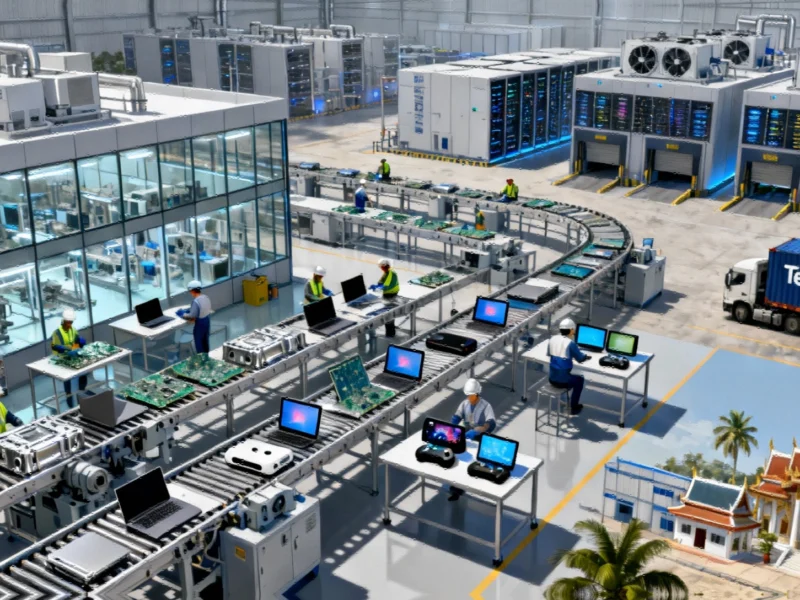In a significant strategic pivot, technology leaders Microsoft, Amazon Web Services, and Google are intensifying efforts to diversify their manufacturing and data center operations away from China, according to recent supply chain reports. This movement reflects broader supply chain transformation trends affecting multiple industries as companies seek to mitigate geopolitical risks and build more resilient production networks.
Microsoft’s Ambitious Manufacturing Transition
Microsoft is spearheading this shift with aggressive targets to relocate up to 80% of components for its Surface notebooks, tablets, and data center infrastructure outside China by 2026. The company’s comprehensive strategy encompasses both component manufacturing and final assembly for future notebook and server products, representing one of the most substantial supply chain realignments in recent years.
The tech giant has reportedly instructed existing partners to establish manufacturing capabilities beyond Chinese borders starting next year. Additionally, Microsoft is accelerating plans to transfer partial production of its Xbox gaming consoles to alternative Asian locations, signaling a broad-based approach to supply chain diversification that mirrors broader corporate restructuring initiatives seen across global industries.
AWS and Google Follow Strategic Path
Amazon Web Services is conducting thorough evaluations of its procurement strategies, particularly regarding printed circuit boards for AI data centers. The cloud computing leader is considering reducing purchases from long-standing Chinese supplier SYE as part of its risk mitigation strategy. This cautious approach demonstrates how companies are balancing existing relationships with emerging geopolitical realities.
Google, meanwhile, is actively expanding its server production capabilities in Thailand, where it has secured multiple partners for components, parts, and assembly operations. The Southeast Asian nation is emerging as a key alternative manufacturing hub, benefiting from international development support and growing infrastructure investments in the region.
Implementation Challenges and Industry Context
Despite ambitious timelines, industry analysts note that rapid supply chain relocation faces significant hurdles. China’s established manufacturing ecosystem offers unparalleled technical expertise, production scale, and component availability that cannot be easily replicated elsewhere. The complexity of modern electronics manufacturing, involving thousands of specialized components and sophisticated assembly processes, makes complete diversification particularly challenging.
The current supply chain restructuring occurs against a backdrop of escalating trade measures between the U.S. and China, including reciprocal tariffs, tightened export controls on critical components, and restrictions on technology sales. These developments have accelerated corporate contingency planning, similar to how major consumer goods companies are reevaluating their global operational footprints.
Broader Implications for Global Manufacturing
This strategic shift by technology leaders signals a potential watershed moment for global manufacturing networks. As companies seek to balance cost efficiency with supply chain security, countries across Southeast Asia, Latin America, and Eastern Europe stand to benefit from redirected investment. The transition also highlights growing corporate recognition that geopolitical factors now represent critical business considerations alongside traditional economic metrics.
The evolving situation demonstrates how technological sovereignty concerns are influencing corporate strategy, with implications extending beyond the tech sector to affect industrial automation and manufacturing infrastructure worldwide. As these realignments progress, they may create new opportunities for emerging manufacturing hubs while challenging China’s dominant position in global electronics production.
Industry observers note that while Chinese manufacturers continue to demonstrate remarkable technological innovation capabilities, the current geopolitical climate is forcing multinational corporations to develop more distributed and resilient supply chain models that can withstand political and trade disruptions.
Based on reporting by {‘uri’: ‘techcrunch.com’, ‘dataType’: ‘news’, ‘title’: ‘TechCrunch’, ‘description’: ‘Tech news with an emphasis on early stage startups, raw innovation, and truly disruptive technologies. Got a tip? [email protected]’, ‘location’: {‘type’: ‘place’, ‘geoNamesId’: ‘5391959’, ‘label’: {‘eng’: ‘San Francisco’}, ‘population’: 805235, ‘lat’: 37.77493, ‘long’: -122.41942, ‘country’: {‘type’: ‘country’, ‘geoNamesId’: ‘6252001’, ‘label’: {‘eng’: ‘United States’}, ‘population’: 310232863, ‘lat’: 39.76, ‘long’: -98.5, ‘area’: 9629091, ‘continent’: ‘Noth America’}}, ‘locationValidated’: False, ‘ranking’: {‘importanceRank’: 175185, ‘alexaGlobalRank’: 1802, ‘alexaCountryRank’: 764}}. This article aggregates information from publicly available sources. All trademarks and copyrights belong to their respective owners.



